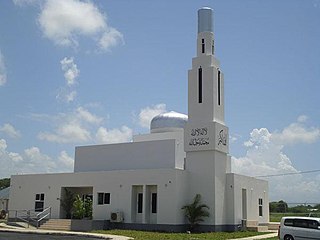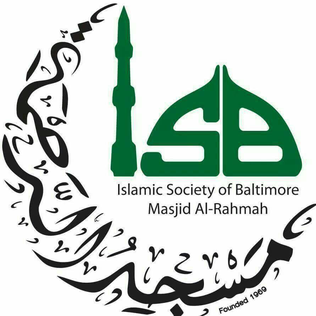A mosque, also called a masjid, is a place of worship for Muslims. The term usually refers to a covered building, but can be any place where Islamic prayers are performed, such as an outdoor courtyard.

Catonsville is a census-designated place (CDP) in Baltimore County, Maryland. The population was 44,701 at the 2020 US Census. The community is a streetcar suburb of Baltimore along the city's western border. The town is known for its proximity to the Patapsco River and Patapsco Valley State Park, making it a regional mountain biking hub. The town is also notable as a local hotbed of music, earning it the official nickname of "Music City, Maryland." Catonsville contains the majority of the University of Maryland, Baltimore County (UMBC), a major public research university with close to 14,000 students.

Warith Deen Mohammed, also known as W. Deen Mohammed, Imam W. Deen Muhammad and Imam Warith Deen, was an African-American Muslim leader, theologian, philosopher, Muslim revivalist, and Islamic thinker.

Jamaica is a predominantly Christian country, with Islam being a minority religion. Due to the secular nature of Jamaica's constitution, Muslims are free to proselytize and build places of worship in the country.

The holiest sites in Islam are predominantly located in the Arabian Peninsula and the Levant. While the significance of most places typically varies depending on the Islamic sect, there is a consensus across all mainstream branches of the religion that affirms three cities as having the highest degree of holiness, in descending order: Mecca, Medina, and Jerusalem. Mecca's Al-Masjid al-Haram, Al-Masjid an-Nabawi in Medina and Al-Masjid al-Aqsa in Jerusalem are all revered by Muslims as sites of great importance.
Gwynn Oak is an unincorporated community in the western part of Baltimore City, Maryland, United States. Gwynn Oak is north of Liberty Road and east of Rogers Avenue Windsor Mill Road. Nearby neighborhoods include: Woodlawn, Milford Mill, Windsor Mill, and Garwyn Oaks. The western edge of the community lies just outside Woodlawn town center, north-east of Windsor Mill Road where Woodlawn Drive becomes Gwynn Oaks Avenue. The community was home to the Gwynn Oak Amusement Park, now Gwynn Oak Park.
Masjid As-Sabur is the oldest mosque, and the pioneering Muslim organization, in the city of Las Vegas, Nevada.
The Islamic Society of Western Maryland (ISWMD), located in Hagerstown, Maryland, is a mosque which was the first permanent structure to be built specifically to serve as a mosque in Western Maryland. The mosque was built in 1994, after the American Revolutionary War-era home proved to be insufficient to accommodate the growing community.

Masjid Malcolm Shabazz, formerly known as Mosque No. 7, is a Sunni Muslim mosque in Harlem, New York City. It was formerly a Nation of Islam mosque at which Malcolm X preached, until he left it for Sunni Islam in 1964.

The Kaaba, sometimes referred to as al-Ka'ba al-Musharrafa is a stone building at the center of Islam's most important mosque and holiest site, the Masjid al-Haram in Mecca, Saudi Arabia. It is considered by Muslims to be the Bayt Allah and is the qibla for Muslims around the world. The current structure was built after the original building was damaged by fire during the siege of Mecca by Umayyads in 683.
The American Society of Muslims was a predominantly African-American association of Muslims which was the direct descendant of the original Nation of Islam. It was created by Warith Deen Mohammed after he assumed leadership of the Nation of Islam upon the death of his father Elijah Muhammad. Warith Deen Mohammed changed the name of the Nation of Islam to the "World Community of Islam in the West" in 1976, then the "American Muslim Mission" in 1981, and finally the "American Society of Muslims" in 1988.
Mohammed Adam El-Sheikh is the Sudanese American executive director of the Fiqh Council of North America.

The Islamic Society of Greater Houston (ISGH) is a system of mosques in Greater Houston. It is headquartered at the Eastside Main Center in Upper Kirby in Houston.

The Islamic Society of Baltimore (ISB) is a Muslim community center located in Catonsville, Baltimore County, Maryland, consisting of Masjid Al-Rahmah, Al-Rahmah School, and several other services. The society was founded in 1969 by three Muslim physicians and is known for then-President Barack Obama's visit on February 3, 2016. As of 2019, the society serves around 3,000 people.
There is a significant population of American Muslims in the Dallas–Fort Worth metroplex. Dallas-Fort Worth is home to sixty-two Sunni mosques. According to AbdelRahman Murphy, a Chicago-born, Irving-based Islamic teacher and Muslim community leader, other U.S.-based Muslims now refer to Dallas as the "Medina of America". Not only is Dallas Masjid Al Islam the oldest Muslim community in the DFW area, it established the first mosque in the city of Dallas and established the first Muslim school in the DFW area. As of 2021, many major Muslim organizations and charities have headquarters or operations in DFW, mostly located in Richardson, Texas such as: ICNA Dallas, Muslim American Society, Muslim Legal Fund of America, Helping Hands for Relief & Development, Sabrina Memorial Foundation, Islamic Relief USA, CAIR-Texas, and MA’RUF. There are also several institutions of research and higher education such as: Qalam Institute (Carrollton), ISRA Foundation (Plano), Bayyina Academy (Euless), and The Islamic Seminary of America (Richardson). -
Mosque No. 12, also known as Masjid Makkah, is a mosque in Philadelphia, Pennsylvania. It came to prominence in the early 1960s when a building was leased by the Nation of Islam, converted for use as a mosque, and placed under the direction of Malcolm X, who was a minister there and at Mosque No. 7 until he left the organization for Sunni Islam in 1964.

Islam is the third most widely professed religion in New York City, after Christianity and Judaism. A 2018 study estimated that there are over 750,000 Muslims living in New York City, the largest population of Muslims by city in the United States. Approximately 9% of New York City residents are Muslim, constituting 22.3% of American Muslims, with 1.5 million Muslims in the greater New York metropolitan area, representing the largest metropolitan Muslim population in the Americas.—and the most ethnically diverse Muslim population of any city in the world.

Islam in Washington, D.C. is the third largest religion, after Christianity and Judaism. As of 2014, Muslims were 2% of Greater Washington's population was Muslim. Around 50,000 Muslims live in DC. DC's Muslim history dates to the early 1600s, when the first Muslim residents were enslaved and formerly enslaved African Americans. DC is home to seven mosques, including some of the oldest mosques in the United States. A copy of the Quran owned by Thomas Jefferson is held at the Library of Congress.
















